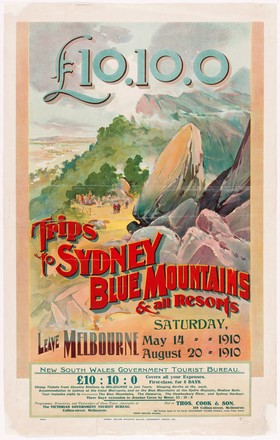‘One of the first things that strikes a visitor to Sydney, is the way they cater for travellers. It is certainly an object lesson to our Government. In Martin Place, opposite the Post Office is the GOVERNMENT TOURIST BUREAU, and according to the views of people who have travelled all over the globe, is second to none in the world….
Catching the 10.15 train from Sydney on Monday the 27th, my destination was Katoomba, which is situated in the heart of the WORLD FAMED BLUE MOUNTAINS.
After partaking of dinner I caught a drag for Wentworth Falls, which are among the leading sights of the mountains. The Government must have spent a mint of money, which shows their enterprise, in making the points of vantage, as the Yankee would say, "get at-able." The mountains are truly-named, as the mist in the never-ending valleys is of a distinctly blue colour. The Valley of the Waters, a gap containing no less than 20 waterfalls, in the descent of over 1800 feet to the valley, has to be seen to be realised. By the time we got back to the coach the sun had gone down, and it was bitterly cold. Roaring fires were in every house when we got back to Katoomba, and they were welcome, too. At Sydney you could wear your thinnest apparel, so muggy was the atmosphere, but here, 65 miles away in the mountains, you could not get enough clothes on your back. Tuesday was a beautiful day, quiet oppressive in fact, and I had planned a visit to the Katoomba Falls for the morning, and had decided to walk. I was well repaid for my trouble. There are two falls of great depth, with beautiful silvery cascades in the centre, and at the foot of the second fall - the centre cascades, from the soft flowing gossamer appearance, are often called the Bridal Veil. At this popular sight over 1000 feet of cliff face are presented to the admiring gaze. The expanse of rugged walls, and the glorious panorama of valley and distant cliffs, with fern and foliage, are exceedingly beautiful. It is dreadfully tiring, though, tramping down and up the numberless steps for a man with an unnecessary amount of adipose tissue like myself. In the afternoon I caught the train from Katoomba to Medlow Bath, to view this fashionable holiday resort for visitors. It is situated. 70 miles from Sydney, and is styled a palace situated in a wilderness. It is really up-to-date with every particular. There is an art gallery a quarter of a mile long, including many works of great masters, a gorgeous miniature theatre, luxurious billiard room, tennis court, croquet lawn, lounges, piazza, etc. From the latter, then is a magnificent view of the Kalimna Valley.’
Malvern Standard, Sat. 2 May 1908, p. 3



 Back to list
Back to list